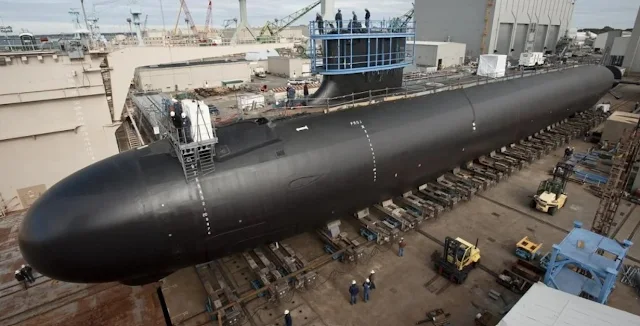 |
| Specifications Of Ohio Class and Columbia Class, The Largest Submarines US Navy That Ever Existed |
International Military - Designed in the 1970s, Ohio class submarines are quite old. However, the United States Navy (US) still uses the Ohio-class submarines and does not replace them.
On June 4, the US Navy laid the keel for the USS District of Columbia, the first of its new Columbia-class nuclear-powered ballistic missile submarine, at the Electric Boat facility at Quonset Point, Rhode Island.
The high-level event was attended by Admiral Daryl Caudle, commander of US Fleet Forces Command, and Secretary of the Navy Carlos Del Toro, who said the Columbia class 'will be the cornerstone of our strategic deterrence' and 'the ultimate guarantor of our national security'.
Laying over this major milestone, however, are longstanding problems for the Columbia program, unforeseen delays and technical difficulties that could limit the Navy's ability to deliver nuclear and conventional missiles.
Compounding this problem is a recent report from the Office of Government Accountability that, in addition to difficulties in cataloging Columbia's programs, noted that the program's overall costs had increased by $3.4 billion to a projected $112 billion.
Quoted from 19fortyfive.com, with nuclear-powered ballistic missile submarines (classified as SSBNs) carrying 70% of America's deployed nuclear arsenal, the prospect of a delay has led the Navy to consider extending the life of some of the older SSBNs, although some are nearing exhaustion. their own service life.
At 560 feet long, 43 feet wide and weighing 20,810 tons, the Columbia class will be the largest submarine ever built by the US. In addition to the Mk 48 Advanced Capability torpedoes, the submarine will carry 16 Trident II D5 submarine ballistic missiles, each of which has a range of over 7,500 miles and can carry up to eight independently targetable multiple reentry vehicles.
The ship will have a service life of 42 years and have a number of upgrades and upgrades over its Ohio-class predecessors. This includes "superior acoustic performance and advanced sensors to make it the most capable and silent submarine ever built," according to the Navy.
One significant improvement is that each Columbia-class reactor does not need to be refueled during its planned life, making the reactor more cost-effective and allowing the submarine to operate for a longer time. The Columbia class is also being co-developed with the Royal Navy's Dreadnaught class SSBN.
Both classes will have a Common Missile Compartment, part of a submarine jointly developed by US-based Electric Boat and UK-based BAE Systems which will house the SLBM. Both ships will also be armed with the Trident II D5.
The Navy plans to build a total of 12 Columbia-class ships. Construction on the USS District of Columbia is currently underway and construction on a second, USS Wisconsin, will begin in March 2024.
The US Navy's Ohio-class submarines are currently America's largest submarines. They are slightly smaller than the Columbia class, measuring 560 feet long and 42 feet wide and weighing 18,750 tons, but the Ohio-class submarines are more armed than the Columbia, with four torpedo tubes and 24 Trident II D-5 SLBMs.
The Columbia-class submarine will also be the largest submarine the Navy has ever built. It has boats that are 560 feet long with a beam of 43 feet and a displacement of 21,000 tons.
According to Naval Technology, the US Navy placed a $5 billion detailed design contract with General Dynamics Electric Boat for the Columbia-class submarine program in September 2017.
General Dynamics Electric Boat awarded a $468 million subcontract to Newport News Shipbuilding to support the construction of the submarine in December 2017.
Newport News Shipbuilding is responsible for engineering analysis, component development, detail planning and technical services. Electric Boat acts as prime contractor for the submarine program, with 80% of the work being done by Electric Boat and the remaining 20% being handed over by Newport News Shipbuilding.
These two shipbuilders will involve multiple vendors and suppliers to do the work. Later, each submarine in the Columbia class is expected to carry out 124 deterrence patrols during its 42-year service life.
